LINCOLN MKZ 2013 Owners Manual
Manufacturer: LINCOLN, Model Year: 2013, Model line: MKZ, Model: LINCOLN MKZ 2013Pages: 474, PDF Size: 3.79 MB
Page 221 of 474
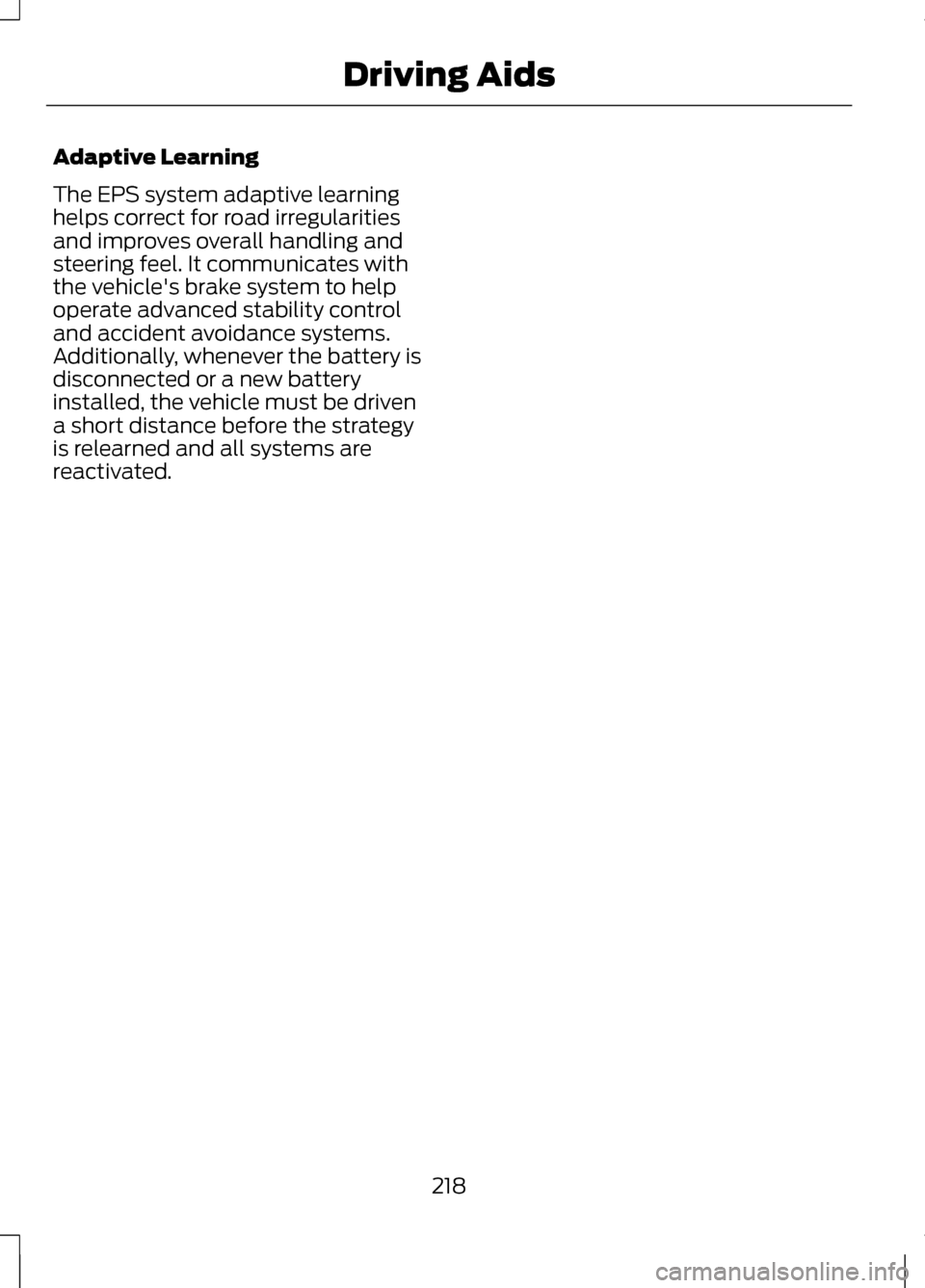
Adaptive Learning
The EPS system adaptive learning
helps correct for road irregularities
and improves overall handling and
steering feel. It communicates with
the vehicle's brake system to help
operate advanced stability control
and accident avoidance systems.
Additionally, whenever the battery is
disconnected or a new battery
installed, the vehicle must be driven
a short distance before the strategy
is relearned and all systems are
reactivated.
218
Driving Aids
Page 222 of 474
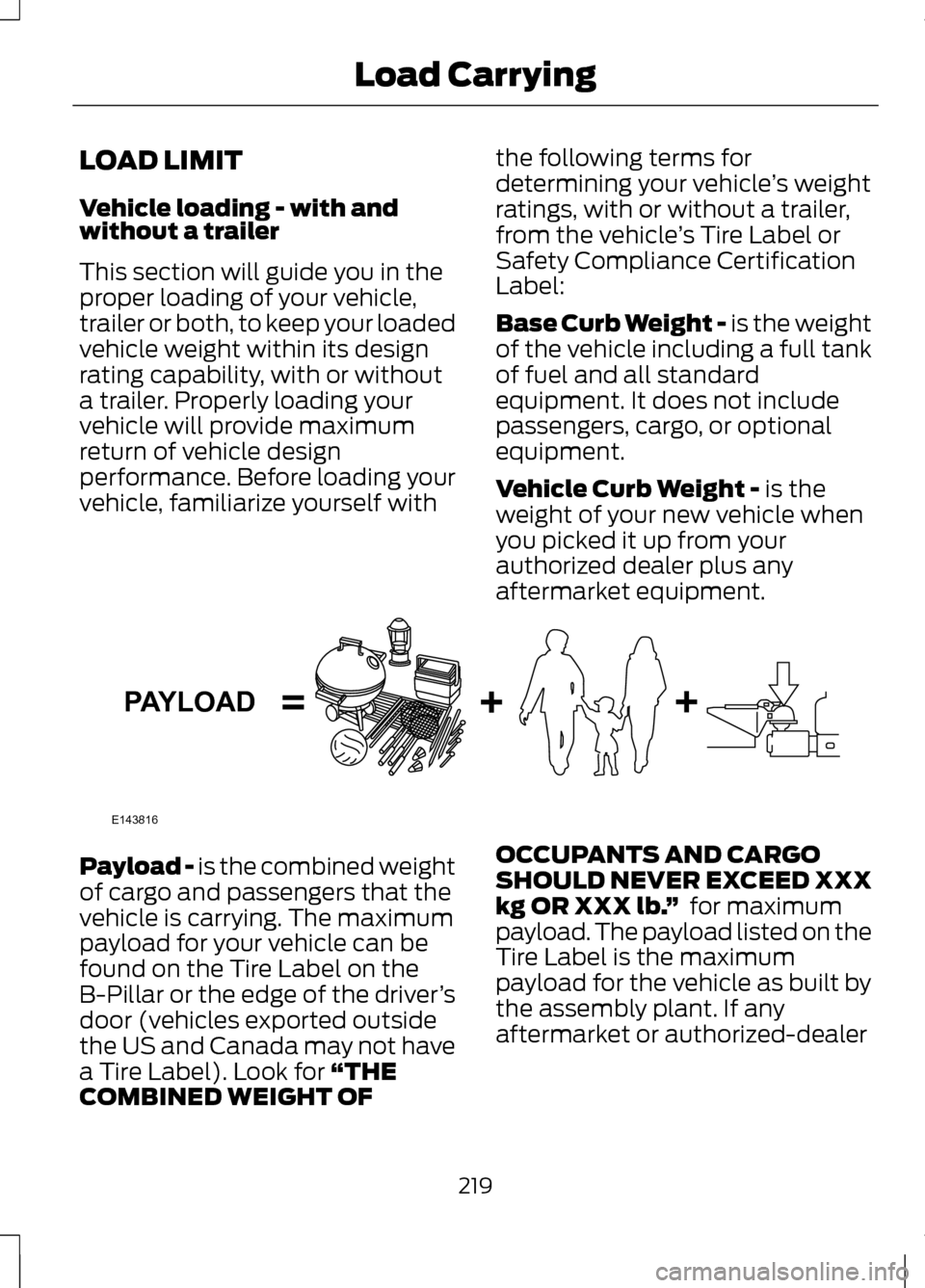
LOAD LIMIT
Vehicle loading - with and
without a trailer
This section will guide you in the
proper loading of your vehicle,
trailer or both, to keep your loaded
vehicle weight within its design
rating capability, with or without
a trailer. Properly loading your
vehicle will provide maximum
return of vehicle design
performance. Before loading your
vehicle, familiarize yourself with
the following terms for
determining your vehicle
’s weight
ratings, with or without a trailer,
from the vehicle ’s Tire Label or
Safety Compliance Certification
Label:
Base Curb Weight - is the weight
of the vehicle including a full tank
of fuel and all standard
equipment. It does not include
passengers, cargo, or optional
equipment.
Vehicle Curb Weight -
is the
weight of your new vehicle when
you picked it up from your
authorized dealer plus any
aftermarket equipment. Payload -
is the combined weight
of cargo and passengers that the
vehicle is carrying. The maximum
payload for your vehicle can be
found on the Tire Label on the
B-Pillar or the edge of the driver ’s
door (vehicles exported outside
the US and Canada may not have
a Tire Label). Look for
“THE
COMBINED WEIGHT OF OCCUPANTS AND CARGO
SHOULD NEVER EXCEED XXX
kg OR XXX lb.
” for maximum
payload. The payload listed on the
Tire Label is the maximum
payload for the vehicle as built by
the assembly plant. If any
aftermarket or authorized-dealer
219
Load CarryingE143816PAYLOAD
Page 223 of 474
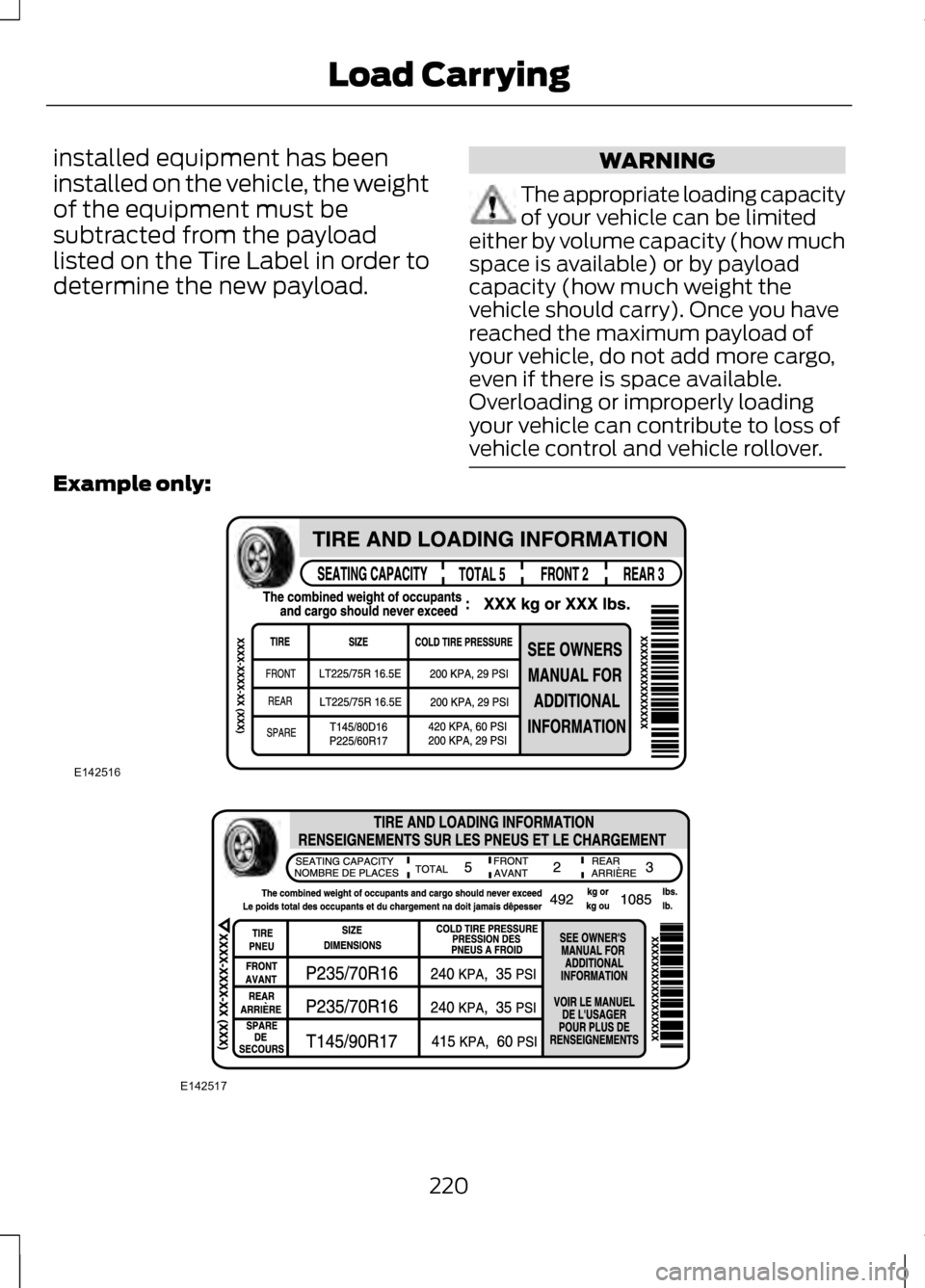
installed equipment has been
installed on the vehicle, the weight
of the equipment must be
subtracted from the payload
listed on the Tire Label in order to
determine the new payload.
WARNING
The appropriate loading capacity
of your vehicle can be limited
either by volume capacity (how much
space is available) or by payload
capacity (how much weight the
vehicle should carry). Once you have
reached the maximum payload of
your vehicle, do not add more cargo,
even if there is space available.
Overloading or improperly loading
your vehicle can contribute to loss of
vehicle control and vehicle rollover. Example only:
220
Load CarryingE142516 E142517
Page 224 of 474
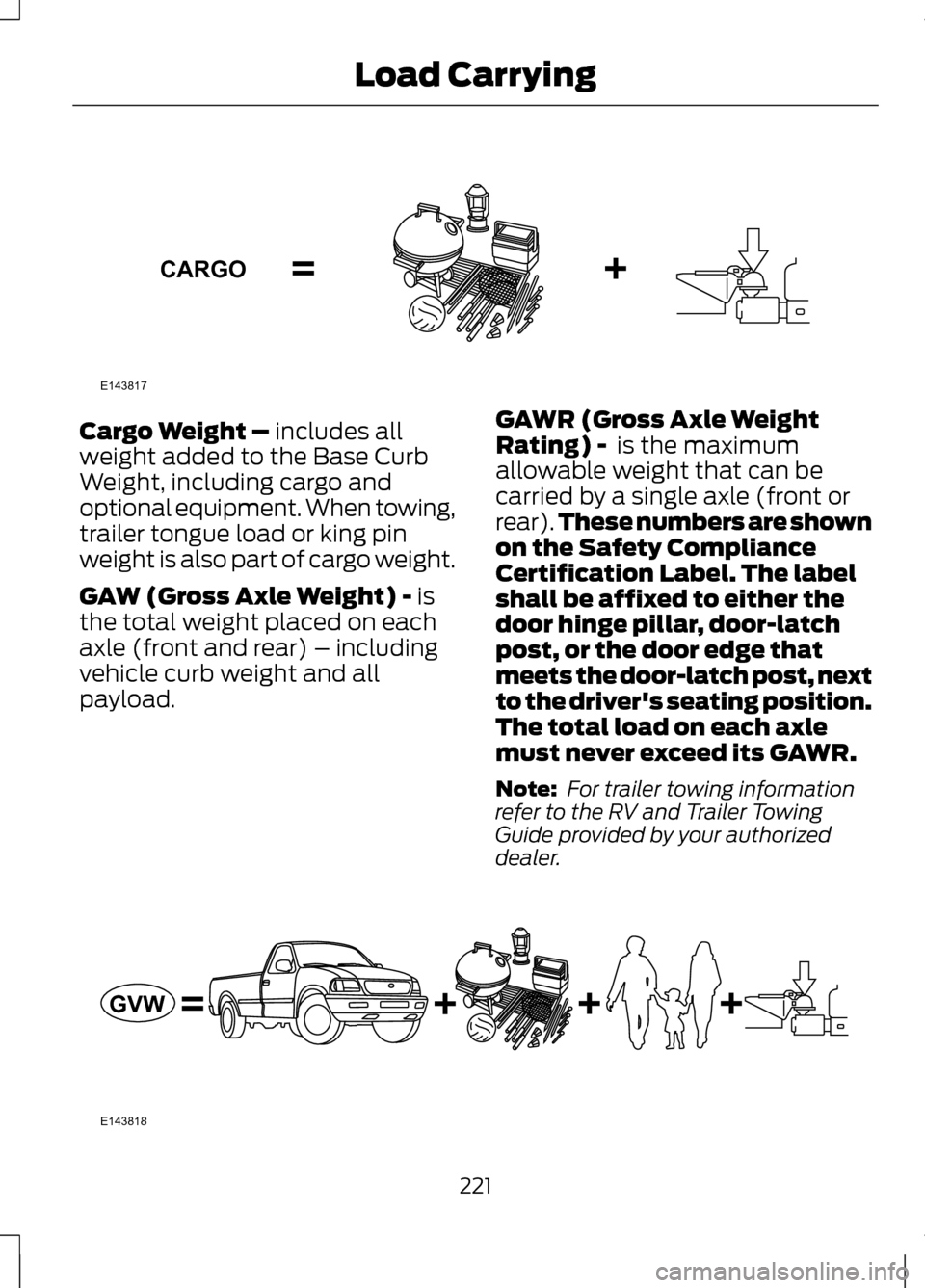
Cargo Weight – includes all
weight added to the Base Curb
Weight, including cargo and
optional equipment. When towing,
trailer tongue load or king pin
weight is also part of cargo weight.
GAW (Gross Axle Weight) -
is
the total weight placed on each
axle (front and rear) – including
vehicle curb weight and all
payload. GAWR (Gross Axle Weight
Rating) -
is the maximum
allowable weight that can be
carried by a single axle (front or
rear). These numbers are shown
on the Safety Compliance
Certification Label. The label
shall be affixed to either the
door hinge pillar, door-latch
post, or the door edge that
meets the door-latch post, next
to the driver's seating position.
The total load on each axle
must never exceed its GAWR.
Note: For trailer towing information
refer to the RV and Trailer Towing
Guide provided by your authorized
dealer. 221
Load CarryingE143817CARGO E143818GVW
Page 225 of 474
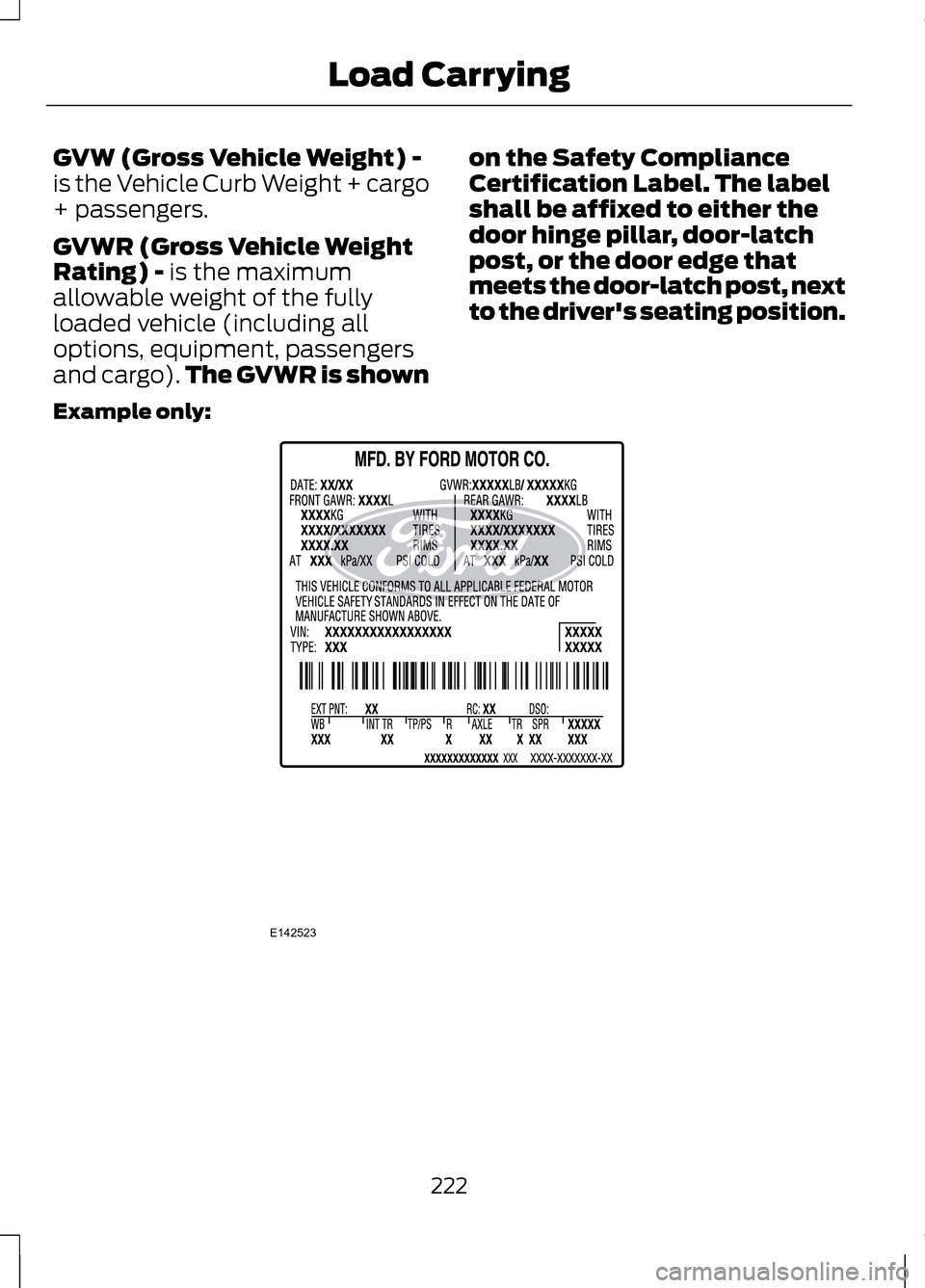
GVW (Gross Vehicle Weight) -
is the Vehicle Curb Weight + cargo
+ passengers.
GVWR (Gross Vehicle Weight
Rating) - is the maximum
allowable weight of the fully
loaded vehicle (including all
options, equipment, passengers
and cargo). The GVWR is shown on the Safety Compliance
Certification Label. The label
shall be affixed to either the
door hinge pillar, door-latch
post, or the door edge that
meets the door-latch post, next
to the driver's seating position.
Example only: 222
Load CarryingE142523
Page 226 of 474
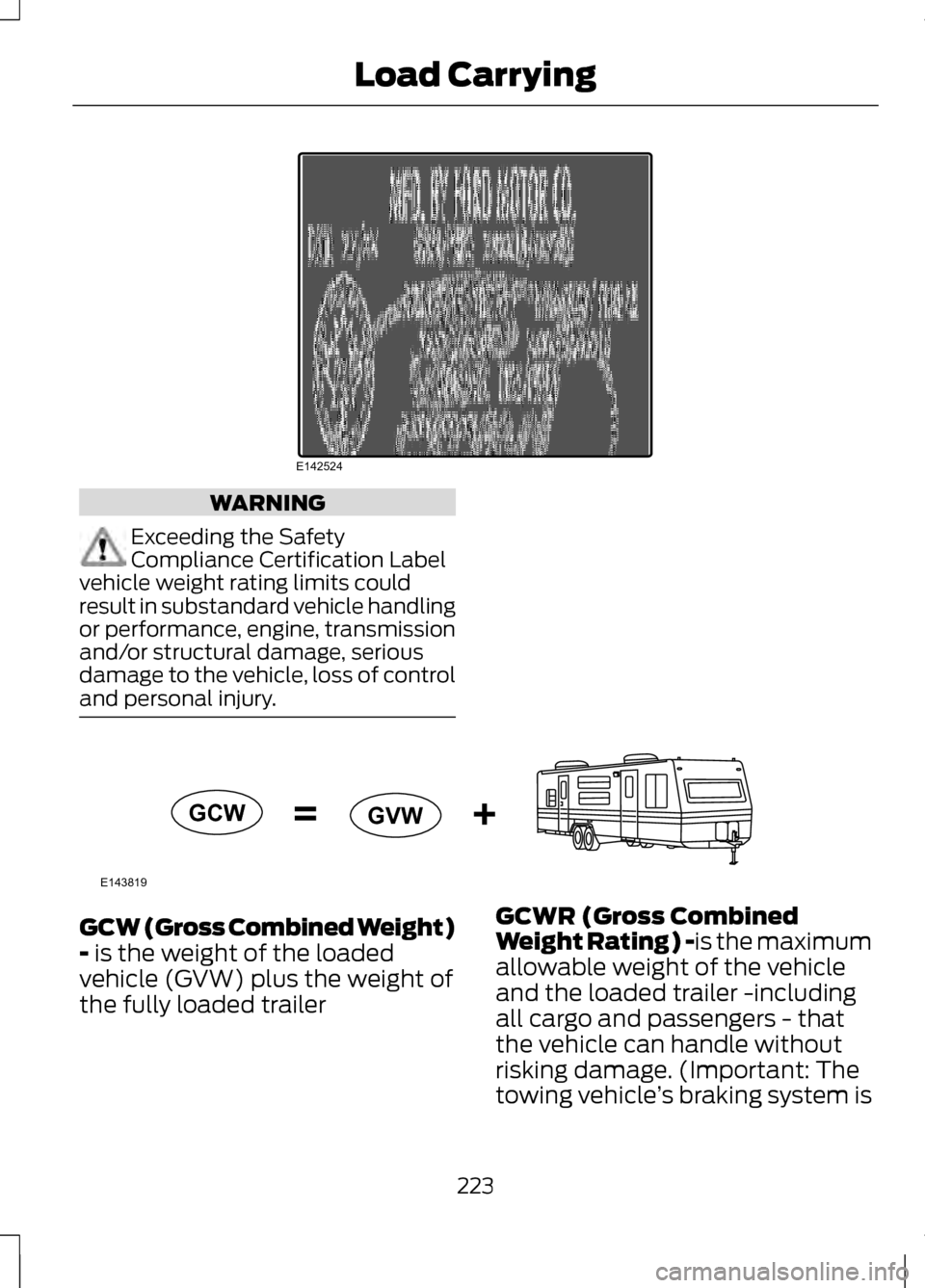
WARNING
Exceeding the Safety
Compliance Certification Label
vehicle weight rating limits could
result in substandard vehicle handling
or performance, engine, transmission
and/or structural damage, serious
damage to the vehicle, loss of control
and personal injury. GCW (Gross Combined Weight)
- is the weight of the loaded
vehicle (GVW) plus the weight of
the fully loaded trailer GCWR (Gross Combined
Weight Rating) -is the maximum
allowable weight of the vehicle
and the loaded trailer -including
all cargo and passengers - that
the vehicle can handle without
risking damage. (Important: The
towing vehicle
’s braking system is
223
Load CarryingE142524 E143819GCW
GVW
Page 227 of 474
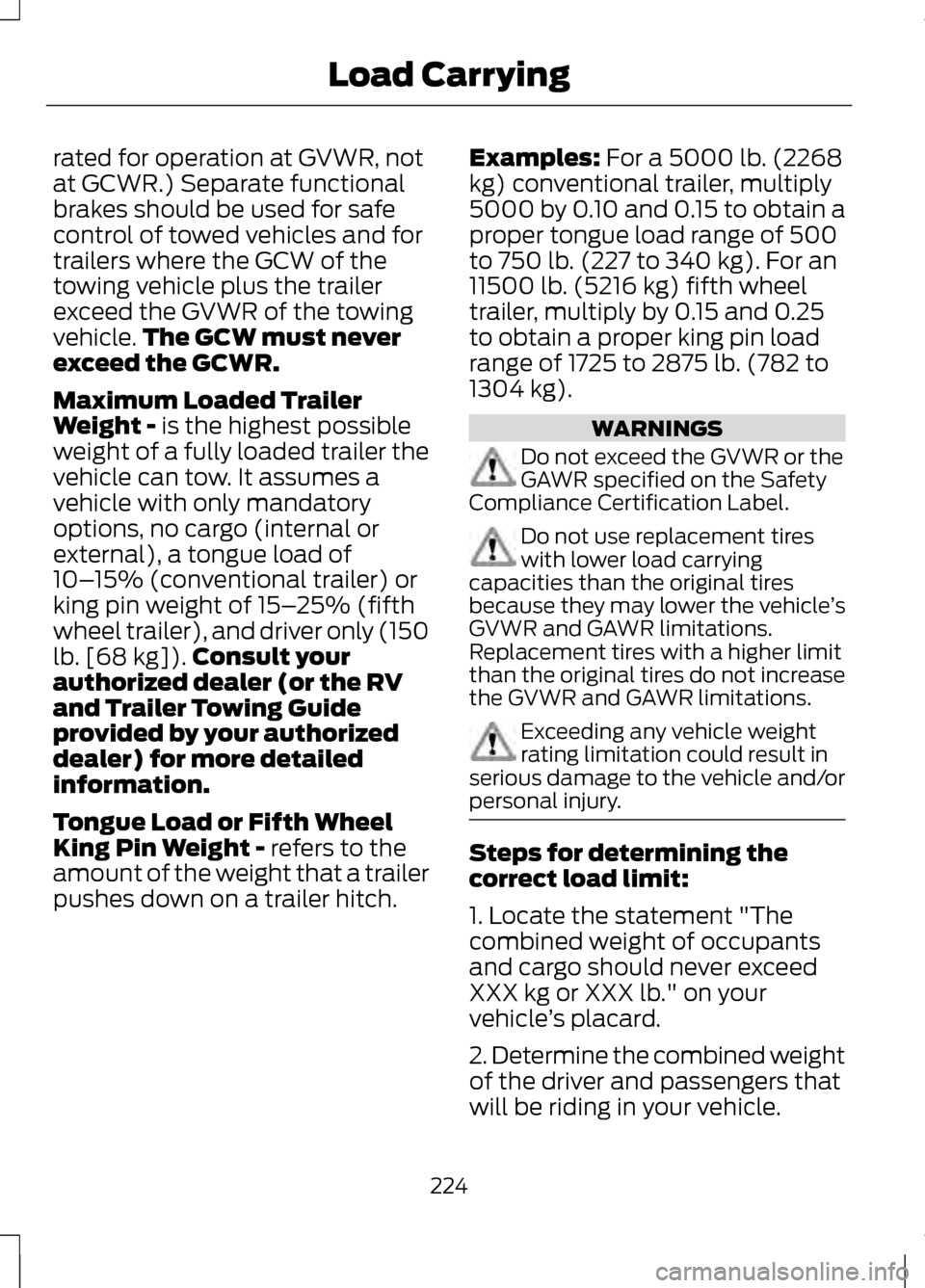
rated for operation at GVWR, not
at GCWR.) Separate functional
brakes should be used for safe
control of towed vehicles and for
trailers where the GCW of the
towing vehicle plus the trailer
exceed the GVWR of the towing
vehicle.
The GCW must never
exceed the GCWR.
Maximum Loaded Trailer
Weight - is the highest possible
weight of a fully loaded trailer the
vehicle can tow. It assumes a
vehicle with only mandatory
options, no cargo (internal or
external), a tongue load of
10– 15% (conventional trailer) or
king pin weight of 15– 25% (fifth
wheel trailer), and driver only (150
lb. [68 kg]). Consult your
authorized dealer (or the RV
and Trailer Towing Guide
provided by your authorized
dealer) for more detailed
information.
Tongue Load or Fifth Wheel
King Pin Weight -
refers to the
amount of the weight that a trailer
pushes down on a trailer hitch. Examples:
For a 5000 lb. (2268
kg) conventional trailer, multiply
5000 by 0.10 and 0.15 to obtain a
proper tongue load range of 500
to 750 lb. (227 to 340 kg). For an
11500 lb. (5216 kg) fifth wheel
trailer, multiply by 0.15 and 0.25
to obtain a proper king pin load
range of 1725 to 2875 lb. (782 to
1304 kg). WARNINGS
Do not exceed the GVWR or the
GAWR specified on the Safety
Compliance Certification Label. Do not use replacement tires
with lower load carrying
capacities than the original tires
because they may lower the vehicle ’s
GVWR and GAWR limitations.
Replacement tires with a higher limit
than the original tires do not increase
the GVWR and GAWR limitations. Exceeding any vehicle weight
rating limitation could result in
serious damage to the vehicle and/or
personal injury. Steps for determining the
correct load limit:
1. Locate the statement "The
combined weight of occupants
and cargo should never exceed
XXX kg or XXX lb." on your
vehicle
’s placard.
2. Determine the combined weight
of the driver and passengers that
will be riding in your vehicle.
224
Load Carrying
Page 228 of 474
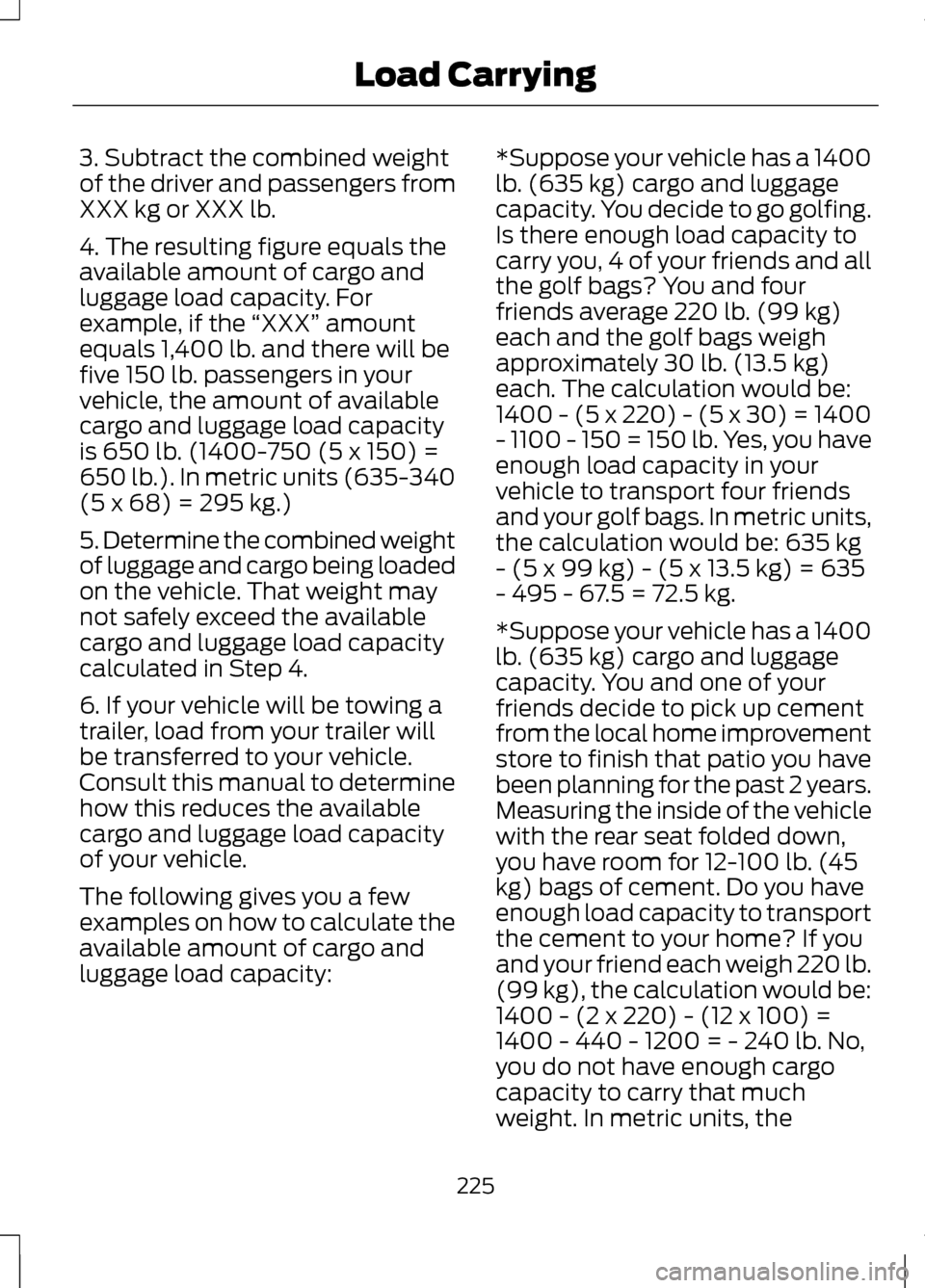
3. Subtract the combined weight
of the driver and passengers from
XXX kg or XXX lb.
4. The resulting figure equals the
available amount of cargo and
luggage load capacity. For
example, if the
“XXX” amount
equals 1,400 lb. and there will be
five 150 lb. passengers in your
vehicle, the amount of available
cargo and luggage load capacity
is 650 lb. (1400-750 (5 x 150) =
650 lb.). In metric units (635-340
(5 x 68) = 295 kg.)
5. Determine the combined weight
of luggage and cargo being loaded
on the vehicle. That weight may
not safely exceed the available
cargo and luggage load capacity
calculated in Step 4.
6. If your vehicle will be towing a
trailer, load from your trailer will
be transferred to your vehicle.
Consult this manual to determine
how this reduces the available
cargo and luggage load capacity
of your vehicle.
The following gives you a few
examples on how to calculate the
available amount of cargo and
luggage load capacity: *Suppose your vehicle has a 1400
lb. (635 kg) cargo and luggage
capacity. You decide to go golfing.
Is there enough load capacity to
carry you, 4 of your friends and all
the golf bags? You and four
friends average 220 lb. (99 kg)
each and the golf bags weigh
approximately 30 lb. (13.5 kg)
each. The calculation would be:
1400 - (5 x 220) - (5 x 30) = 1400
- 1100 - 150 = 150 lb. Yes, you have
enough load capacity in your
vehicle to transport four friends
and your golf bags. In metric units,
the calculation would be: 635 kg
- (5 x 99 kg) - (5 x 13.5 kg) = 635
- 495 - 67.5 = 72.5 kg.
*Suppose your vehicle has a 1400
lb. (635 kg) cargo and luggage
capacity. You and one of your
friends decide to pick up cement
from the local home improvement
store to finish that patio you have
been planning for the past 2 years.
Measuring the inside of the vehicle
with the rear seat folded down,
you have room for 12-100 lb. (45
kg) bags of cement. Do you have
enough load capacity to transport
the cement to your home? If you
and your friend each weigh 220 lb.
(99 kg), the calculation would be:
1400 - (2 x 220) - (12 x 100) =
1400 - 440 - 1200 = - 240 lb. No,
you do not have enough cargo
capacity to carry that much
weight. In metric units, the
225
Load Carrying
Page 229 of 474

calculation would be: 635 kg - (2
x 99 kg) - (12 x 45 kg) = 635 - 198
- 540 = -103 kg. You will need to
reduce the load weight by at least
240 lb. (104 kg). If you remove
3-100 lb. (45 kg) cement bags,
then the load calculation would
be: 1400 - (2 x 220) - (9 x 100) =
1400 - 440 - 900 = 60 lb. Now
you have the load capacity to
transport the cement and your
friend home. In metric units, the
calculation would be: 635 kg - (2
x 99 kg) - (9 x 45 kg) = 635 - 198
- 405 = 32 kg.
The above calculations also
assume that the loads are
positioned in your vehicle in a
manner that does not overload
the Front or the Rear Gross Axle
Weight Rating specified for your
vehicle on the Safety Compliance
Certification Label. The label shall
be affixed to either the door hinge
pillar, door-latch post, or the door
edge that meets the door-latch
post, next to the driver's seating
position.
226
Load Carrying
Page 230 of 474
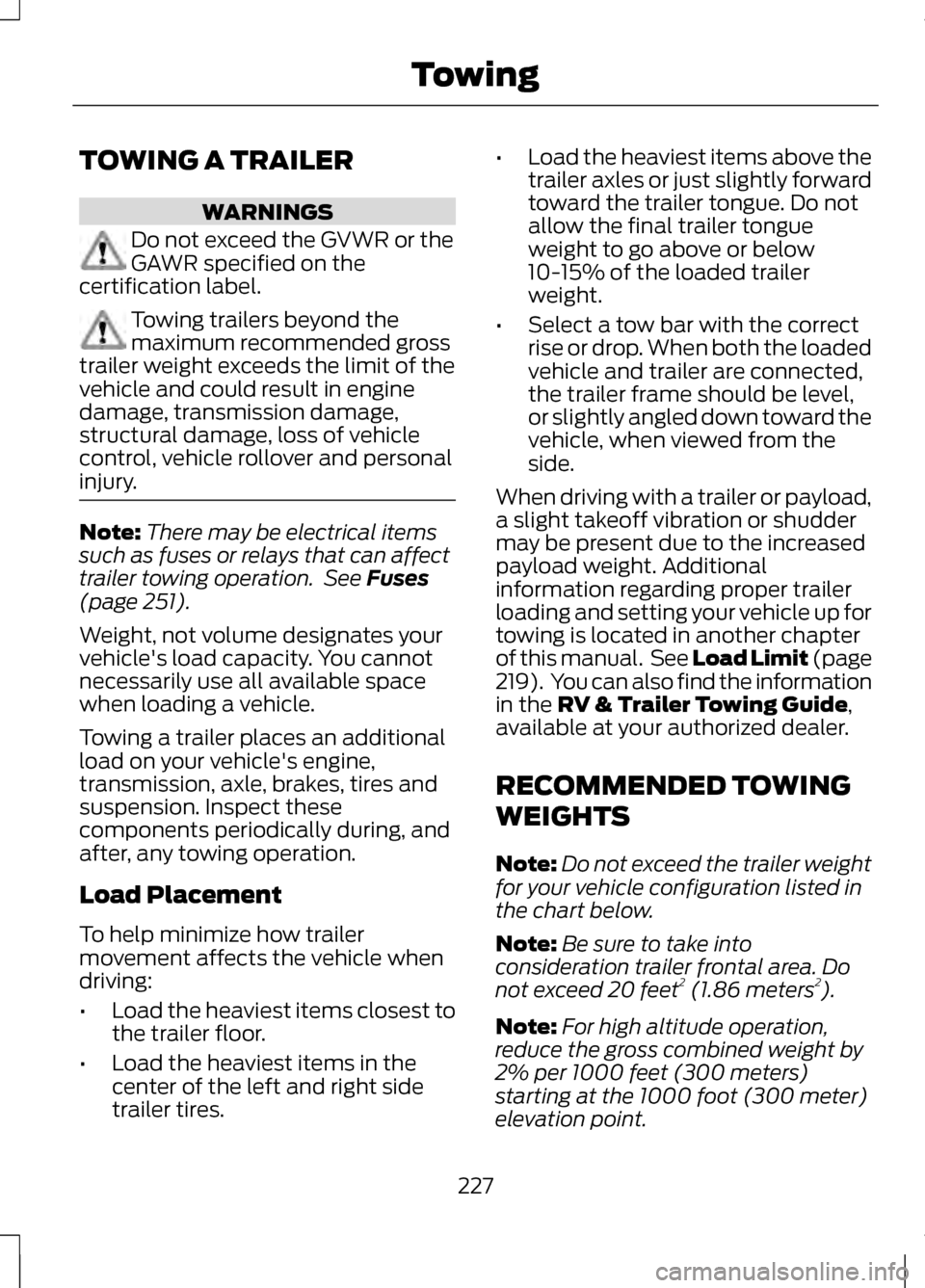
TOWING A TRAILER
WARNINGS
Do not exceed the GVWR or the
GAWR specified on the
certification label. Towing trailers beyond the
maximum recommended gross
trailer weight exceeds the limit of the
vehicle and could result in engine
damage, transmission damage,
structural damage, loss of vehicle
control, vehicle rollover and personal
injury. Note:
There may be electrical items
such as fuses or relays that can affect
trailer towing operation. See Fuses
(page 251).
Weight, not volume designates your
vehicle's load capacity. You cannot
necessarily use all available space
when loading a vehicle.
Towing a trailer places an additional
load on your vehicle's engine,
transmission, axle, brakes, tires and
suspension. Inspect these
components periodically during, and
after, any towing operation.
Load Placement
To help minimize how trailer
movement affects the vehicle when
driving:
• Load the heaviest items closest to
the trailer floor.
• Load the heaviest items in the
center of the left and right side
trailer tires. •
Load the heaviest items above the
trailer axles or just slightly forward
toward the trailer tongue. Do not
allow the final trailer tongue
weight to go above or below
10-15% of the loaded trailer
weight.
• Select a tow bar with the correct
rise or drop. When both the loaded
vehicle and trailer are connected,
the trailer frame should be level,
or slightly angled down toward the
vehicle, when viewed from the
side.
When driving with a trailer or payload,
a slight takeoff vibration or shudder
may be present due to the increased
payload weight. Additional
information regarding proper trailer
loading and setting your vehicle up for
towing is located in another chapter
of this manual. See Load Limit (page
219). You can also find the information
in the
RV & Trailer Towing Guide,
available at your authorized dealer.
RECOMMENDED TOWING
WEIGHTS
Note: Do not exceed the trailer weight
for your vehicle configuration listed in
the chart below.
Note: Be sure to take into
consideration trailer frontal area. Do
not exceed 20 feet 2
(1.86 meters 2
).
Note: For high altitude operation,
reduce the gross combined weight by
2% per 1000 feet (300 meters)
starting at the 1000 foot (300 meter)
elevation point.
227
Towing